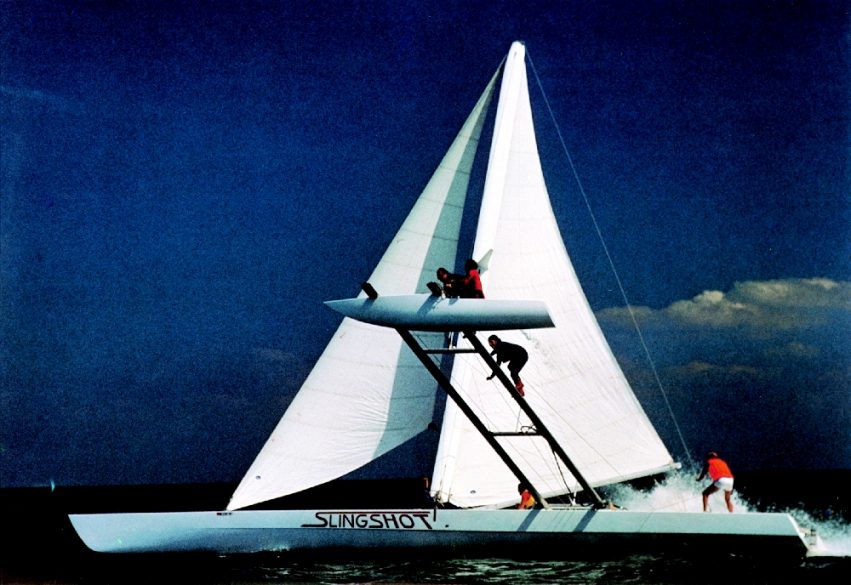
by Bruce Niederer — GBI Technical Advisor
Above: The proa Slingshot was one of the true pioneers of speed, topping out at 40 knots.
There are those who believe sailing fast means advanced composites with high-tech fibers, exotic cores, and plenty of cash. Very few think of wood when they think of fast, but before carbon fiber, before Kevlar™…there was wood.
I’m not talking about those great big lumbering tall ships or schooners. I’m talking about the pioneers of boatbuilding and fast sailboat racing. Men of vision who saw wood not just as planks and large hunks of trees to be bolted together, but as an engineering fiber. Men like Walter Greene, Jim Brown, James Wharram, Dick Newick, and the Gougeon Brothers: Joel, Meade, and Jan.
Meade and Jan were first introduced to epoxy resins by Vic Carpenter, a boatbuilder who was one of the earliest users of epoxy as a structural adhesive to build boats. Vic built the Olin Stephens-designed 36′ Yare in 1963 using strip planked Honduras Mahogany. In 2008 it was the second oldest boat in the Bayview Mac Race, the 46th Mac race for the boat with a second-place finish in their class to add to their 11 firsts. Fast as it is, it is still basically a traditional-style boat that employed epoxy adhesive in the build.
The wheels started turning. The Brothers enlisted the help of some friends who worked for Dow Chemical in formulating an epoxy adhesive that could be also used as a coating to take advantage of epoxy’s excellent moisture resistance.
Soon the three brothers began using the newly formulated epoxy system to build improved DN iceboats. These rapidly began winning races due to the added stiffness and durability the epoxy provided to the wooden structures. Everyone wanted one. By 1973, Gougeon Brothers Boatworks was the largest builder of iceboats in the country. In 1975 they sold the iceboat business to concentrate on selling epoxy and building larger custom boats. Joel focused on managing the fledgling epoxy business and didn’t race nearly as much as his brothers. Through it all, Meade and Jan never stopped racing. Here’s a quick list of Meade and Jan’s winter sailing accomplishments in DNs:
Meade won the North American title in 1980 and again in 1997 when he was 58 years old. He is the oldest person ever to win the North American DN championship. His record still stands today. Jan won his eighth North American DN championship in 2000. That’s more than any other American sailor. He won four World DN championships won over the course of three decades. (1972, 1982, 1985 and 1991) and also won the Great Cup of Siberia Race in Russia in 1989.
As of this writing, Meade and Jan were ranked 25th and 18th respectively in the Gold Fleet world standings of the IDNIYRA (International DN Ice Yacht Racing Association). They vow to improve those positions this year.

2009 marks the 40th anniversary of Gougeon Brothers, Inc. Over the years an impressive number of fast boats emerged from the Gougeon Brothers boat shop including 14 production/custom water ballasted, trailerable, catamarans—the Gougeon 32 (G32).
I say the G32s were production/custom boats because they are mostly the same, but like all things Gougeon, each build sparked ideas and innovations that found their way into the next build.
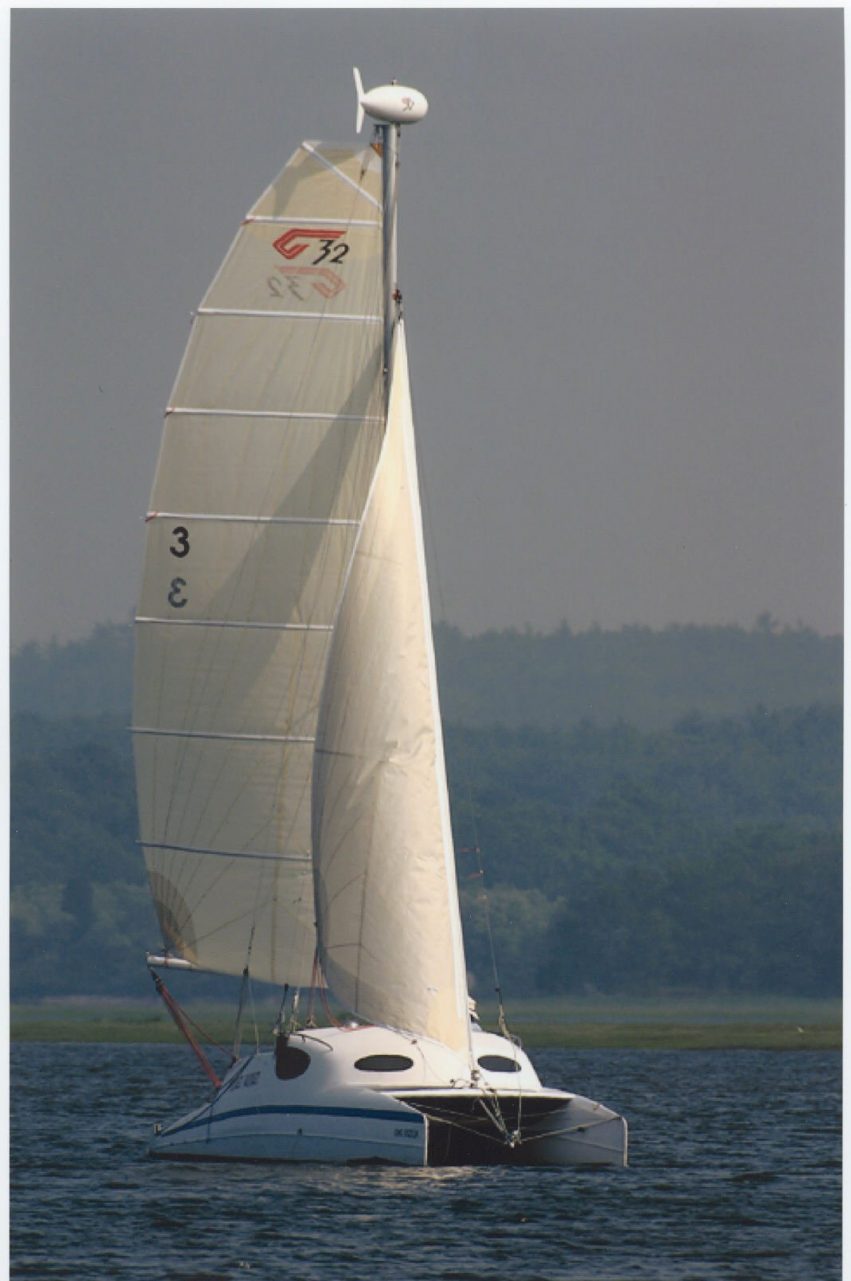
The Brothers built several high-profile racing sailboats that advanced and refined the construction techniques they developed while building iceboats and a series of experimental trimarans beginning in the late 1950s. Together they built an experimental 25′ trimaran to IYRU Class C rules that marks the start of their early racing success at the 1963–1964 NAMSA Championships at Stamford, Conn.Building on this success and experience, Meade constructed Victor T in 1967–1968. He got the boat’s weight down to 320 lb and it earned the distinction of being the lightest Class C competitor in the 1969 Nationals in Hamilton, Ontario. There, Victor T took home the win against a strong field of wingmast-powered catamarans.
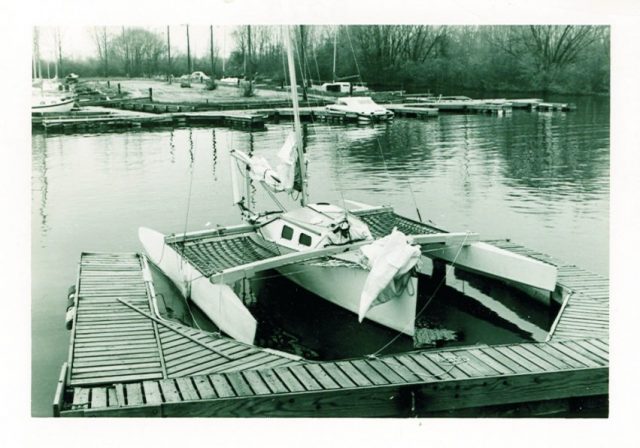
Next came Adagio, launched in 1970 and believed to be the first all bonded and sealed wooden structure built entirely without fasteners, using a unique building method which they called “developed plywood construction.” She’s a testament to the longevity of wood/epoxy construction, and to the competitiveness and seamanship of her only skipper. Meade has racked up a long and impressive string of trophies throughout the Great Lakes.
Meade first raced Adagio in the Bayview-Mac (Port Huron to Mackinac Island) race in 1996 and placed second behind another boat that many have come to know well (and also built with WEST SYSTEM® Epoxy) Earth Voyager. The result of the long love affair between Meade and Adagio is an impressive race history on the Great Lakes which continues today.
Adagio’s Port Huron-to-Mackinac race finishes: 1998 second, 1999 first, 2000 first, 2002 first, 2003 fifth, 2004 fifth, 2005 first, 2006 first, 2007 fifth, 2008 fifth, 2009 second.
Adagio’s Chicago-to-Mackinac finishes: 1998 first, 2000 first to finish, 2002 first to finish, 2006 first to finish, Reick Trophy, 2008.
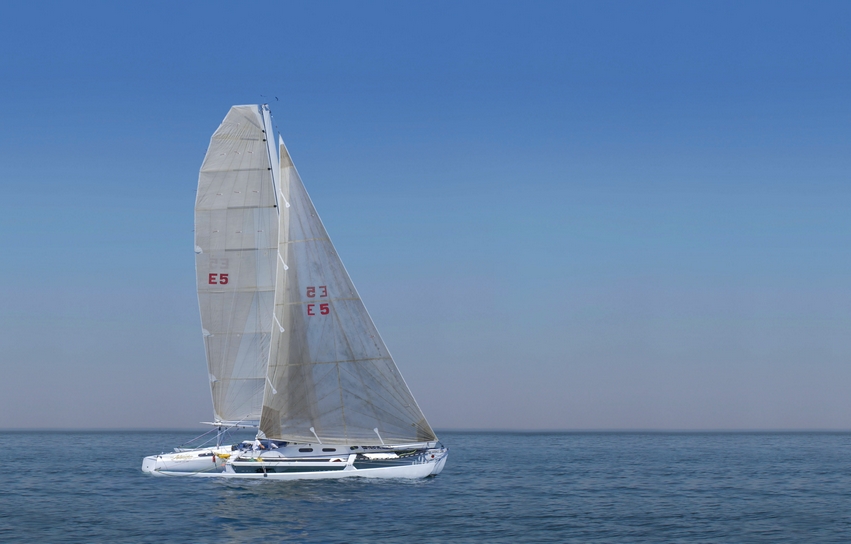
In 1973 they built an Olympic class Tornado catamaran using vacuum-bagged, cold-molded construction. USA sailors David McFaull and Michael Rothwell sailed the boat in the 1976 Olympics and took the Silver medal behind the German team.
The Gougeon Brothers also began construction of Golden Dazy in 1973 for Dr. Gerry Murphy from the Bayview Yacht Club in Detroit. Golden Dazy generated a lot of press and won the 1975 Canada’s Cup. She’s still sailing today in upstate New York.
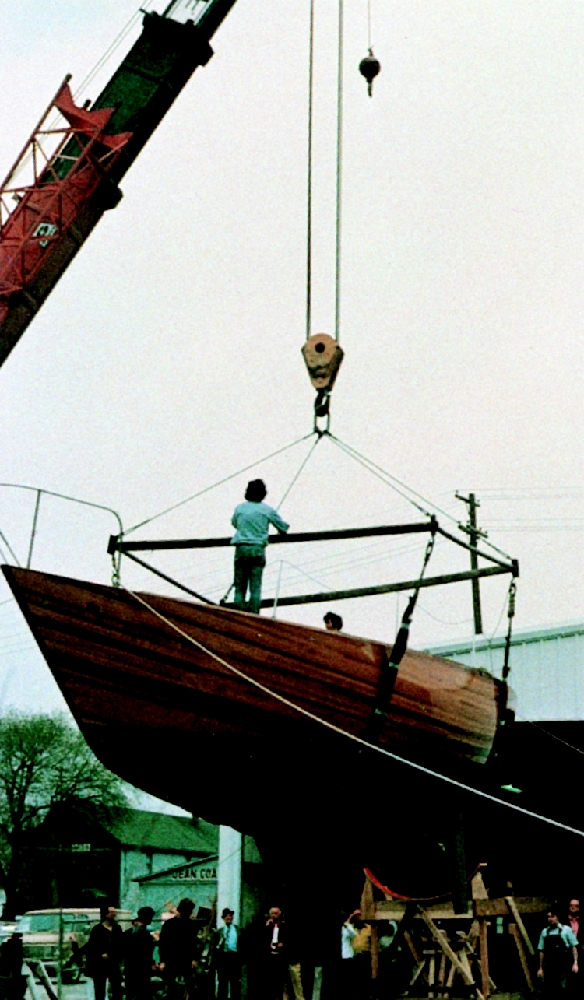
In the mid-Seventies the Gougeon Brothers built Class C catamaran designed by the Hubbard Brothers. The boat was named Patient Lady.
I’m sure some of you will remember the fast monohull the Brothers built next: Hot Flash. This Gary Mull design was commissioned in 1976 by the Usnis brothers, also from the Bayview Yacht Club in Detroit.
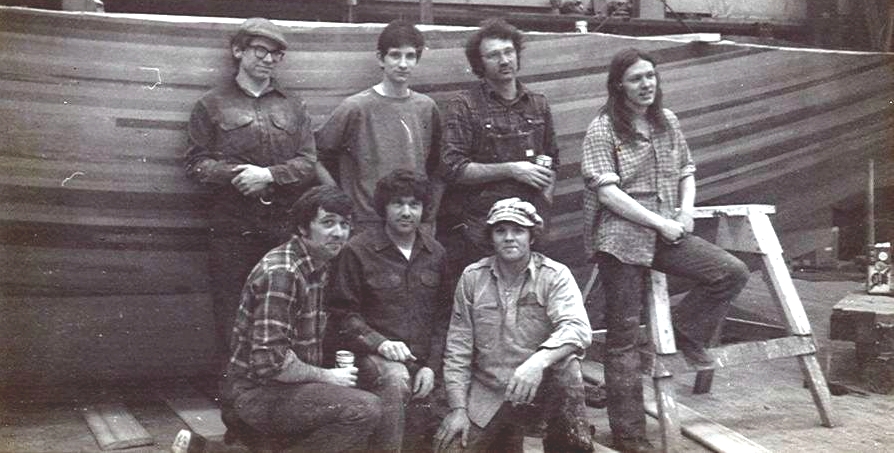
In 1977 the Brothers began building Rogue Wave, a Dick Newick-designed 60′ trimaran for Phil Weld. He had planned to race it in the 1980 OSTAR, but never had the opportunity because of a rule change. Weld did win the 1980 OSTAR, setting a record for the race that year onboard the well-known Moxie, designed by Newick to comply with the new rules. Moxie was built by multihulls guru Walter Greene, a user of WEST SYSTEM Epoxy who is also a good friend of Meade’s.
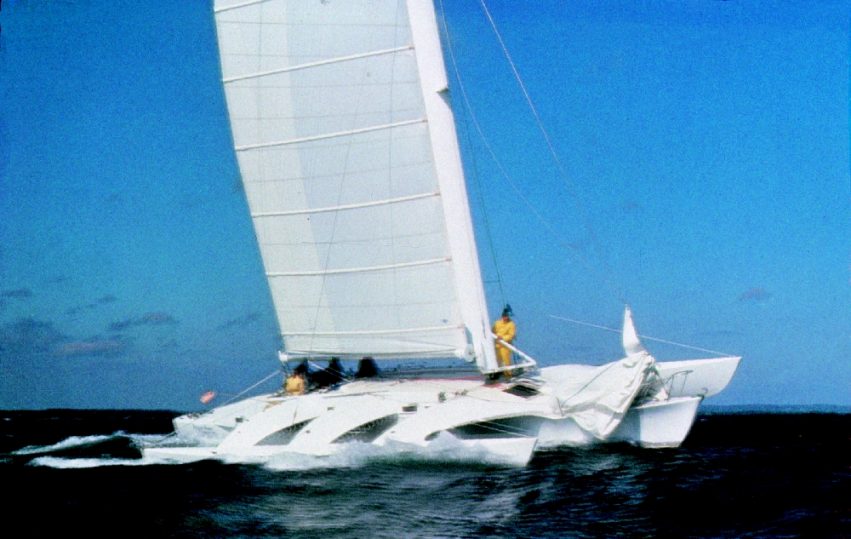
At the Gougeon shop construction also started on Flicka, another plywood cruising trimaran. Jan spent four long days on the capsized Flicka in the Atlantic Ocean during a qualifier for the next OSTAR challenge. He had plenty of time to think about rightable trimaran designs before a passing freighter rescued him. Flicka had to be abandoned at sea.
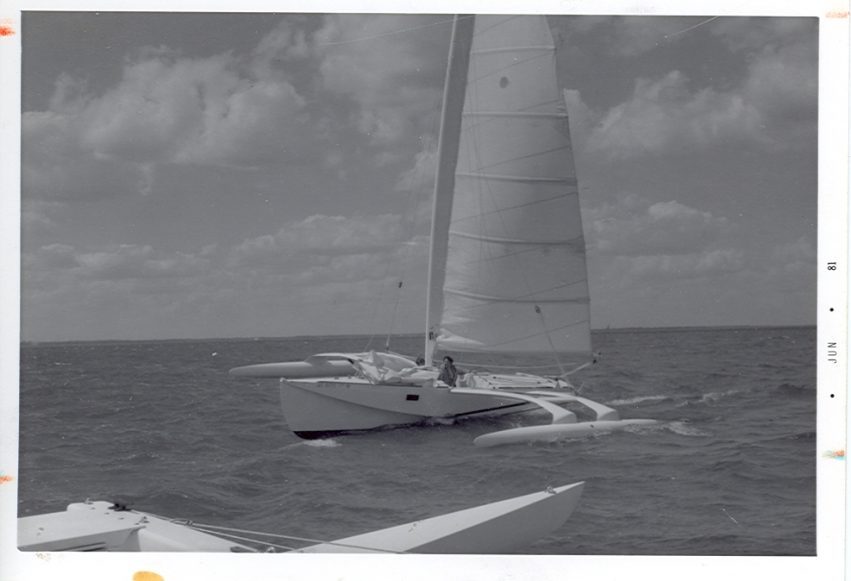
In 1980 Jan designed and began to build Splinter, a developed plywood trimaran designed to be rightable after an offshore capsize. Splinter was the second boat, after Adagio, the Brothers launched with a wingmast. She is now owned and raced by Bob Struble (father of A-Cat and DN champ Matt Struble) in Saginaw Bay and competes against Adagio and another noteworthy Gougeon-built boat, Ollie.
Named after the Gougeons’ grandmother, Ollie was started in 1984 using the developed plywood technology the Brothers had developed over the years. The design was trademarked as a Stressform™ 35 along with Stressform wing mast plans. Ollie’s design advanced Jan’s ideas for self-righting.
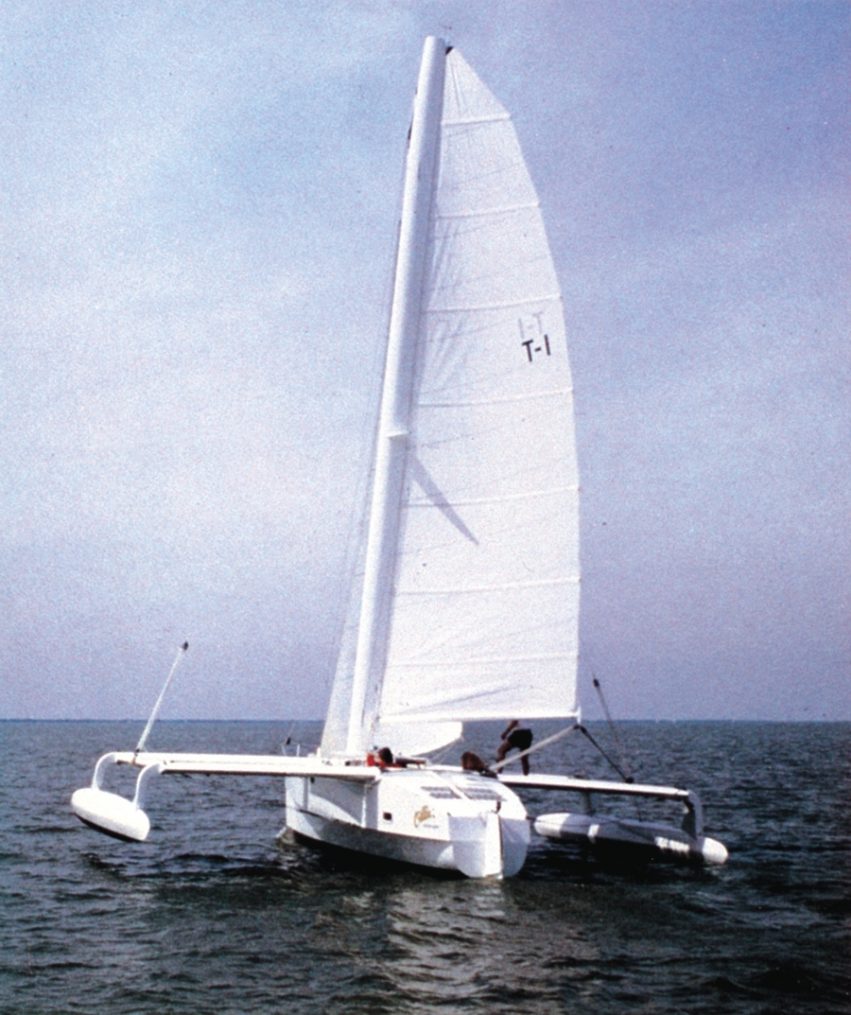
Although Jan can be nostalgic for the boats he’s built, particularly Ollie, he hears a different drummer than Meade. Jan is always thinking of the next boat, whether it’s right around the corner or a few years out. A difference of even greater significance is Jan’s appetite for solo sailing—and he’s done plenty.
Jan raced Splinter in the single-handed Port Huron to Mac race beginning in 1981. He placed first that year and first again in both 1982 and 1983. In 1984 the weather forced most, if not all, of the multihulls off the water, including Jan’s. Race records from the Eighties are hard to come by, and I thank Blair Arden of the Great Lakes Singlehanded Society for digging through his old records to help fill the blanks in. In one of the three races in 1981–1983, Jan set a new record for the fastest finish. Jan couldn’t remember which year it was either, which is typical of Jan; once the race is over he’s taking what he learned and applying it to the next race, the next boat design, the next build, the next challenge.
His record was short-lived because in 1985 he broke his own record for the race in Ollie with a time of 26:09:00—a record that still stands. Weren’t we all in awe of the fully crewed Earth Voyager completing the race in just under 25 hours a few years back? Jan and Ollie ran up a string of firsts from 1985 through 1991 and in 1989 he earned the Peter Fisher Award with his win. Jan also won the singlehanded SuperMac in 1987 with Ollie. That race ran from Port Huron to St. Joseph (just south of Benton Harbor, Michigan) setting another record that still stands today with a time of 77:40:00. The next finisher that year was the C&C 41 C-Spray with a time of 123:59:00—46 hours and 19 minutes after Jan. The loss prompted the skipper of C-Spray to retire the monohull from future singlehanded races!
In 1995 Jan raced his G32 Pocket Rocket in the single-handed classic to claim another first. In 1997 Pocket Rocket was the only multi entered so he scored another first. In 1998, this time with some competition, he finished second.
At times Jan and Ollie have taken some crew with them. 1995 marked the first time multihulls were allowed to race in the Port Huron to Mac race and Ollie finished third followed by Meade and crew on Janet C, a G32. In 1996 Ollie finished third behind Adagio and Earth Voyager and in 1998 Ollie finished eighth.
Ollie was sold to Tim Walli and Dave Sturm in 1998 and didn’t race again that year, but in 1999 Ollie was back with the new owners and Jan as crew. She finished second behind Meade and Adagio. In 2000 Ollie, with Jan as crew again, suffered a fatigue failure in a stainless fitting and retired from the race. Jan has not raced on Ollie since.
The Brothers also built a couple of other noteworthy and well-known boats. The multihull Slingshot was launched in June of 1978. Commissioned by Georg and Carl Thomas, Slingshot was built to compete in the speed trials in Weymouth, England. Slingshot was 60′ × 4.5′ hull beam × 42′ BOA and weighed in at 1,800 lb plus a crew of four. She could sail in both a proa configuration and a trimaran configuration. She recorded the second-fastest speed in 1979 at Weymouth behind the famous Crossbow I which recorded a speed of 31.8 knots—blistering fast in 1979. Jan reports that later that year in Florida they posted an unofficial speed of 40 knots. Racing the ditch in Texas City, Texas in 1980 with a crew of Jan, Mike Zutek, Ron Sherry, and Olaf and Peter Harken, they posted a speed of 38 knots. But alas, during a storm Slingshot came loose from her mooring and was dashed against the rocks and lost forever. All that remains of her is a section of the bow hanging in the Gougeon boat shop.

The last commissioned boat the Brothers built was Adrenalin. Started in 1984 and launched in 1987, she was a trimaran with articulating amas built to Formula 40 rules for Bill Piper of Ossineke, Michigan, and intended to race in the European circuit. She shocked the sailboat racing community by placing a very close second in her first regatta on the Grand Prix circuit in 1988. She raced for two seasons in Europe against the traditional big cats until, as Jan put it, “They couldn’t stand being consistently beaten and changed the rule so the boat became illegal and only cats could race.” Adrenalin was purchased by New Zealander Grant Beck in 2007 and is awaiting his attention to get back on the water.
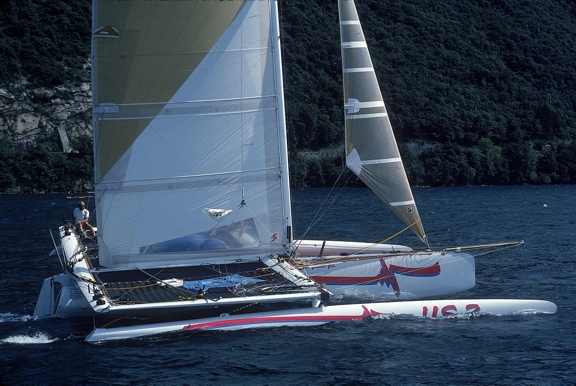
Advancing age has not seemed to slow down either Meade or Jan. This year they sailed Meade’s G32 Janet C in the 2009 Chicago/Mac race to commemorate the 40th anniversary of the company they started together. Being (as of this writing) 70 and 64 years old, respectively, they will no doubt be the oldest average age in the race.
Janet C finished 3rd in the Chicago/Mac race and a week later, Meade, Jan, and Butch Babcock finished 2nd in the Port Huron-to-Mac race on the 39-year-old Adagio.

